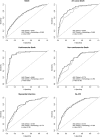Hematological Parameters Improve Prediction of Mortality and Secondary Adverse Events in Coronary Angiography Patients: A Longitudinal Cohort Study
- PMID: 26559287
- PMCID: PMC4912281
- DOI: 10.1097/MD.0000000000001992
Hematological Parameters Improve Prediction of Mortality and Secondary Adverse Events in Coronary Angiography Patients: A Longitudinal Cohort Study
Abstract
Prediction of primary cardiovascular events has been thoroughly investigated since the landmark Framingham risk score was introduced. However, prediction of secondary events after initial events of coronary artery disease (CAD) poses a new challenge. In a cohort of coronary angiography patients (n = 1760), we examined readily available hematological parameters from the UPOD (Utrecht Patient Oriented Database) and their addition to prediction of secondary cardiovascular events. Backward stepwise multivariable Cox regression analysis was used to test their ability to predict death and major adverse cardiovascular events (MACE). Continuous net reclassification improvement (cNRI) and integrated discrimination improvement (IDI) measures were calculated for the hematological parameters on top of traditional risk factors to assess prediction improvement. Panels of 3 to 8 hematological parameters significantly improved prediction of death and adverse events. The IDIs ranged from 0.02 to 0.07 (all P < 0.001) among outcome measures and the cNRIs from 0.11 to 0.40 (P < 0.001 in 5 of 6 outcome measures). In the hematological panels red cell distribution width (RDW) appeared most often. The multivariable adjusted hazard ratio of RDW per 1 standard deviation (SD) increase for MACE was 1.19 [1.08-1.32], P < 0.001. Routinely measured hematological parameters significantly improved prediction of mortality and adverse events in coronary angiography patients. Accurately indicating high-risk patients is of paramount importance in clinical decision-making.
Conflict of interest statement
The authors have no conflicts of interest to disclose.
Figures


Similar articles
-
Routinely analyzed leukocyte characteristics improve prediction of mortality after coronary angiography.Eur J Prev Cardiol. 2016 Jul;23(11):1211-20. doi: 10.1177/2047487315621832. Epub 2015 Dec 7. Eur J Prev Cardiol. 2016. PMID: 26643521
-
Hematological Parameters Outperform Plasma Markers in Predicting Long-Term Mortality After Coronary Angiography.Angiology. 2018 Aug;69(7):600-608. doi: 10.1177/0003319717743679. Epub 2017 Dec 4. Angiology. 2018. PMID: 29202601
-
Hematological parameters and major adverse cardiovascular events: a prospective study in a Chinese population involving 2,970 participants.Int J Med Sci. 2025 Mar 24;22(8):1924-1935. doi: 10.7150/ijms.104118. eCollection 2025. Int J Med Sci. 2025. PMID: 40225871 Free PMC article.
-
Routinely measured hematological parameters and prediction of recurrent vascular events in patients with clinically manifest vascular disease.PLoS One. 2018 Sep 7;13(9):e0202682. doi: 10.1371/journal.pone.0202682. eCollection 2018. PLoS One. 2018. PMID: 30192769 Free PMC article.
-
Biomarkers for risk stratification in secondary cardiovascular prevention. A role of red blood cell distribution width and calcium score.Atherosclerosis. 2016 Mar;246:57-62. doi: 10.1016/j.atherosclerosis.2015.12.041. Epub 2015 Dec 29. Atherosclerosis. 2016. PMID: 26756971
Cited by
-
A machine learning approach using endpoint adjudication committee labels for the identification of sepsis predictors at the emergency department.BMC Emerg Med. 2022 Dec 23;22(1):208. doi: 10.1186/s12873-022-00764-9. BMC Emerg Med. 2022. PMID: 36550392 Free PMC article.
-
The Role of Inflammation in Cardiovascular Outcome.Curr Atheroscler Rep. 2017 Mar;19(3):11. doi: 10.1007/s11883-017-0646-1. Curr Atheroscler Rep. 2017. PMID: 28194569 Review.
-
Preventing unnecessary imaging in patients suspect of coronary artery disease through machine learning of electronic health records.Eur Heart J Digit Health. 2021 Dec 7;3(1):11-19. doi: 10.1093/ehjdh/ztab103. eCollection 2022 Mar. Eur Heart J Digit Health. 2021. PMID: 36713995 Free PMC article.
-
Characteristics of peripheral blood cells are independently related to major adverse cardiovascular events after carotid endarterectomy.Atheroscler Plus. 2023 Jun 1;52:32-40. doi: 10.1016/j.athplu.2023.05.003. eCollection 2023 Jun. Atheroscler Plus. 2023. PMID: 37389152 Free PMC article.
-
White blood cell population dynamics for risk stratification of acute coronary syndrome.Proc Natl Acad Sci U S A. 2017 Nov 14;114(46):12344-12349. doi: 10.1073/pnas.1709228114. Epub 2017 Oct 27. Proc Natl Acad Sci U S A. 2017. PMID: 29087321 Free PMC article.
References
-
- Ridker PM, Buring JE, Shih J, et al. Prospective study of C-reactive protein and the risk of future cardiovascular events among apparently healthy women. Circulation 1998; 98:731–733. - PubMed
-
- Garcia-Moll X, Zouridakis E, Cole D, et al. C-reactive protein in patients with chronic stable angina: differences in baseline serum concentration between women and men. Eur Heart J 2000; 21:1598–1606. - PubMed
-
- Shlipak MG, Sarnak MJ, Katz R, et al. Cystatin C and the risk of death and cardiovascular events among elderly persons. N Engl J Med 2005; 352:2049–2060. - PubMed
Publication types
MeSH terms
Substances
LinkOut - more resources
Full Text Sources
Other Literature Sources
Medical
Miscellaneous

